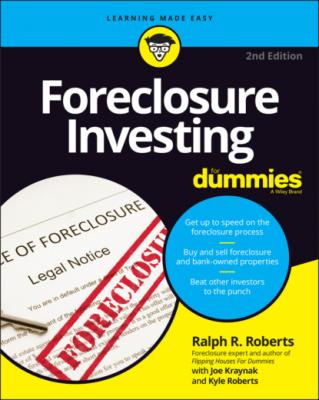Foreclosure Investing For Dummies. Ralph R. Roberts
Чтение книги онлайн.
Читать онлайн книгу Foreclosure Investing For Dummies - Ralph R. Roberts страница 17

The following sections describe these two types of foreclosure. To find out which process your state follows, check the appendix at the back of this book. Counties may also have their own local rules for how the sale is carried out, so visit your county courthouse (the Register of Deeds office), and ask for an explanation of the rules and regulations. I also recommend that you sit in on a few auctions before bidding on anything.
Foreclosure by trustee sale
A few more than half the states follow the trustee-sale route. When the homeowners purchase a property in one of these states, the county issues a sheriff’s deed that the trustee (which may be the sheriff in some areas) holds in trust until the mortgage is paid in full. After paying off the mortgage, the trustee releases the deed to the homeowners.
If the homeowners default on the payment, the lender can notify the trustee to initiate foreclosure proceedings. Then the trustee can sell the property and transfer the proceeds to the lender as payment of the loan. Because the foreclosure doesn’t need to progress through the courts, foreclosure by trustee sale is typically much faster than foreclosure by judicial sale.
Foreclosure by judicial sale
Fewer than half the states follow a judicial foreclosure process. As the name implies, judicial foreclosure passes through the justice system: the state (circuit) or district court. When the homeowners default on their mortgage, the lender files a claim to recover the unpaid balance of the loan from the borrowers. The courts decide the case, which usually takes a long time to resolve — typically four to six months, but sometimes up to a year. During this time, unless the homeowners work out a payment plan or some other solution with the lender, they’re almost guaranteed to lose their home.
Exploring the Missed-Payment Notice Stage
Some lenders initiate foreclosure proceedings as soon as the homeowners miss one or two payments. Other lenders start sending reminder notices, often following a predictable timeline:
Two-week notice: Some lenders give homeowners a two-week grace period, after which they begin to start calling the homeowners or sending them letters.
30-day notice: When a payment is so late that it’s time for the next payment, the lender gets a little jittery and ramps up its efforts. The lender may even begin levying late-payment fees.
45-to-60 days' notice: Unless the homeowners contact the lender and work out some new payment agreement, the lender typically sends out a certified letter insisting that the homeowners pay up.
90-day limit: If the homeowners still haven’t contacted the lender or shown any commitment to make good on the loan, the lender typically initiates formal foreclosure proceedings. At this point, the lender transfers the matter to outside legal counsel (an attorney), and the attorney in charge posts a foreclosure notice, sometimes referred to as a Notice of Default (NOD). As soon as the attorney starts foreclosure by advertisement, these legal notices or advertisements begin to attract investors.
Getting Serious: The Notice of Default
For investors, the foreclosure process officially kicks off with the posting of the NOD or foreclosure notice in the county's legal newspaper or the local newspaper — private, for-profit publications that get the word out to prospective bidders. At this point, distressed homeowners usually realize the inevitability of losing their property. Some remain in denial; others become resigned to the fact, even though they may have several options to abort the foreclosure process and regain control of their property … and their finances.
Proceeding to the Foreclosure Sale
Before the foreclosure sale, the homeowners can work with the lender or their attorney to delay or cancel the foreclosure sale. In other words, just because you see a foreclosure notice in the local paper doesn’t mean that if you show up for the sale, that property is going to be auctioned off.
At the foreclosure sale, you have an opportunity to bid against other investors for any properties that are being auctioned off. As I explain in Chapter 11, some auctions have open bidding; others use a sealed bid system. However your county chooses to hold its auctions, a few words of advice can assist you in acquiring properties and not losing your shirt:
Sit in on at least five auctions before bidding to get a feel for the process and to gather information.
Research the property thoroughly before you bid. In Chapter 8, I explain how to build a file for each property, packed with useful details.
Buy only senior liens (first mortgages). You can really get burned buying junior liens, because foreclosure typically wipes them off the books. When you have more experience and knowledge, you can start working the junior-lien circuit and tax liens, as I discuss in Chapter 15.
Set a maximum bid, and never ever exceed that amount, no matter how juiced up you get at the auction. See Chapter 11 for details on calculating your maximum bid.
When you plan to bid, show up with a cashier’s check. Most auctions require payment at time of purchase or within an hour. For additional information on paying for a property after the auction, check out Chapter 11.
Halting the Foreclosure Process
Distressed homeowners are plagued by a swarm of emotions, ranging from disbelief and resentment to shame and guilt.